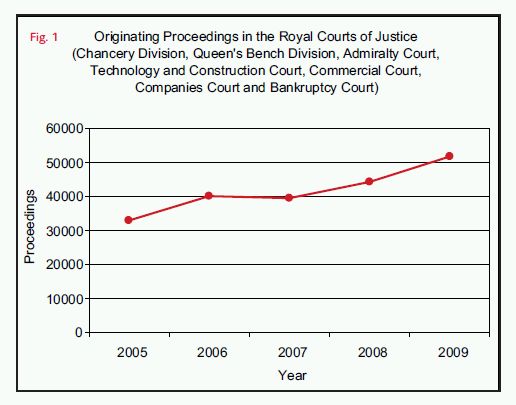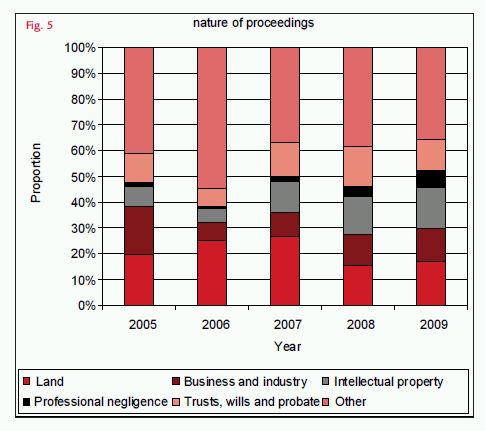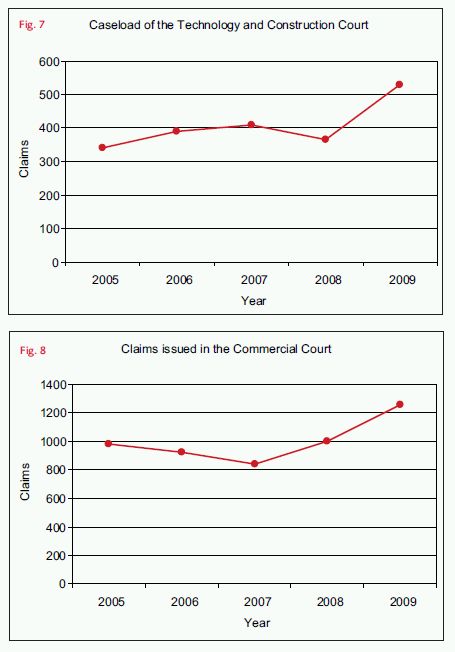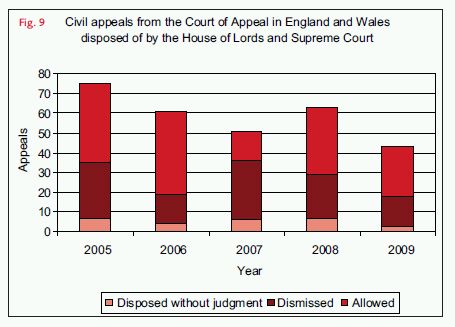The Ministry of Justice's latest report on judicial and court activity in England and Wales for the year 2009 was published on 23 September 2010. While last year's figures suggested that the credit crunch was yet to have the anticipated dramatic impact on court business in 2008, analysis of the 2009 figures indicates that the effects of the economic downturn are now being felt, at least in relation to certain types of claim.
The statistics demonstrate that the steady upward trend in the volume of litigation dealt with by the High Court in London continues. According to the report, in 2009 there were nearly 7,400 more claims or other originating proceedings in the Royal Courts of Justice (excluding the family division) than in the previous year (see Fig. 1). A significant proportion of this figure can be attributed to the Bankruptcy and Companies Courts, which together accounted for over 70 per cent of the increase. Also noteworthy was the jump in the number of claims issued in 2009 in the Admiralty Court (which deals with shipping matters), which more than doubled (see Fig. 2). Given the dramatic downturn in the shipping industry as a result of the global economic crisis, and numerous well publicised insolvencies in 2009, both increases are perhaps not surprising. The gap between the number of claims issued in the Chancery and Queen's Bench Divisions of the Royal Courts of Justice narrowed in 2009 (see Fig. 3). However, claims issued in the Queen's Bench Division still outstripped those in the Chancery Division. Debt and personal injury continued to dominate the Queen's Bench Division, despite a small decrease in the number of debt claims (see Fig. 4), while the distribution of claims in the Chancery Division generally remained fairly evenly spread (see Fig. 5).
However, as expected 2009 did see a notable increase in the number of professional negligence claims issued in the Chancery Division, confirming concerns amongst professional advisers that they would be targeted as in previous downturns. The trend could already be seen in 2008, when 147 professional negligence claims were issued, a 137 per cent increase on the previous year. In 2009, the number of professional negligence claims issued in the Chancery Division had gone up much further to 339, a 131 per cent increase on the 2008 figure, and over five times the number of claims issued in 2007 (see Fig. 6). In the Queen's Bench Division, the number of professional negligence claims issued is not specifically identified. However, the category 'other negligence' includes professional negligence and the statistics show that the number of such claims increased in 2009 to 362, an 87 per cent increase on 2008.
The downturn in the property markets and the effects of the economic crisis on the construction sector are also evident with the number of claims dealt with by the Technology and Construction Court increasing substantially, with 528 claims issued or transferred in 2009, as compared to 366 in 2008 (see Fig. 7). Meanwhile, the Commercial Court continued to see a steady increase in work, with a 25 per cent rise in the number of claims issued in the Royal Courts of Justice since 2008 (see Fig. 8).
October 2009 saw the substitution of the Appellate Committee of the House of Lords with the Supreme Court as the highest court in the UK. The number of civil appeals dealt with by the Supreme Court in the period covered by the 2009 report is too small from which to draw any firm conclusions, standing at only 6; and the drop in the number of cases dealt with by both the House of Lords and the Supreme Court in 2009 is probably as much a result of the changeover as any general downward trend (see Fig. 9). However, the proportions of appeals allowed, dismissed and disposed without judgment by both courts in 2009 were broadly similar to the 2008 House of Lords figures. In the Court of Appeal's civil division, meanwhile, the number of final appeals allowed, dismissed and dismissed by consent, struck out or otherwise disposed of also maintained a level trend (see Fig. 10).
Costs have been a hot topic this year, following the publication of Lord Justice Jackson's final report into the costs of civil litigation in January. Statistics for the Senior Courts Costs Office (previously the Supreme Court Costs Office) demonstrate that in 2009 the number of "between parties" assessments by the court (i.e. assessments of bills to determine how much a successful party can recover from their opponent) dropped slightly, continuing a gentle downwards trend. This is partly attributed to the levelling out of the impact of the scheme for predictable costs in road traffic cases, the reduction in technical challenges to Conditional Fee Agreements and the impact of fixed success fees. However, the (often disproportionate) expense of taking a bill through to detailed assessment is also likely to have been a factor.
Overall the Judicial and Court Statistics 2009 report reveals that the economic downturn is having the expected effect on court business and, while the 2009 figures may not amount to the "claims tsunami" predicted by some, the increase in litigation is there for all to see. Given the continued economic instability this year and the time it takes for disputes to reach the courts, the 2010 figures are unlikely to show a downward trend. We will let you know next year.








The content of this article is intended to provide a general guide to the subject matter. Specialist advice should be sought about your specific circumstances.

